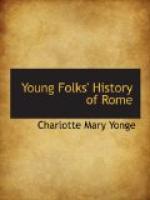[Illustration: POPE GREGORY THE GREAT.]
He was made one of the seven deacons who were called Cardinal Deacons, because they had charge of the poor of the principal parishes of Rome; and it was when going about on some errand of kindness that he saw the English slave children in the market, and planned the conversion of their country; but the people would not let him leave Rome, and in 590, the Senate, the clergy, and the people chose him Pope. It was just then that a terrible pestilence fell on Rome, and he made the people form seven great processions—of clergy, of monks, of nuns, of children, of men, of wives, and of widows—all singing litanies to entreat that the plague might be turned away. Then it was that he beheld an angel standing on the tomb of Hadrian, and the plague ceased. Ever after, the great old tomb has been called the Castle of St. Angelo.
[Illustration: THE POPE’S PULPIT.]
It was a troublous time, but Gregory was so much respected that he was able to keep Rome orderly and safe, and to make peace between the Emperor Maurice and the Lombards’ king, Agilulf, who had an excellent wife, Theodolinda. She was a great friend of the Pope, wrote a letter to him, and did all she could to support him. The Eastern Empire was still owned at Rome, but when there was an attempt to make out that the Patriarch of Constantinople was superior to the Pope, Gregory upheld the principle that no Patriarch had any right to be above the rest, nor to be called Universal Bishop. Gregory was a very great man, and the justice and wisdom of his management did much to make the Romans look to their Pope as the head of affairs even after his death in 604.




